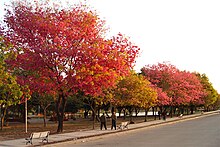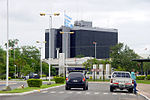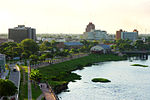Formosa, Argentina
This article needs additional citations for verification. (December 2012) |
Formosa | |
|---|---|
 | |
 Coat of arms | |
 Formosa Location of Formosa in Argentina | |
| Coordinates: 26°11′S 58°11′W / 26.183°S 58.183°WCoordinates: 26°11′S 58°11′W / 26.183°S 58.183°W | |
| Country | |
| Province | |
| Department | Formosa |
| Founded | April 8, 1879 |
| Area | |
| • City | 72,066 km2 (27,825 sq mi) |
| Elevation | 57 m (187 ft) |
| Population (2010 census) | |
| • Urban | 234,000 |
| Demonym(s) | formoseño |
| Time zone | UTC−3 (ART) |
| CPA base | P3600 |
| Dialing code | +54 370 |
| Climate | Cfa |
| Website | Official website |
Formosa (Spanish pronunciation: [foɾˈmosa]) is the capital city of the Argentine province of Formosa, on the banks of the Paraguay River, about 1,200 km (746 mi) from Buenos Aires, on National Route 11. The city has a population of about 234,000 per the 2010 census [INDEC].
Formosa is the hub of the provincial industry, that processes the product of its natural resources. The port that serves the Paraguay towards the Paraná River is the main transport means for the provincial production.
Notable sights of the city include the Nuestra Señora del Carmen Cathedral, the Government House, the Torelli Botanic Forest Garden, the Provincial History Museum (Museo Histórico Provincial), the Estadio Centenario ("Centenary Stadium") football stadium, the Guaicole fauna reserve, the shore of the Paraguay River, the Isla de Oro Island, and the Central Square named after José de San Martín.
History[]
The lands were initially inhabited by Toba and Wichí (Mataco) aboriginals. On April 8, 1879 Commander Luis Jorge Fontana founded the settlement that would become the capital of the National Territory of Chaco from 1884 to June 15, 1955, when it gained the status of province. The Formosa campus of the National University of the Northeast was established as the National University of Formosa in 1988.[citation needed]
The name of the city (and the province) comes from the archaic Spanish word fermosa (currently hermosa) meaning "beautiful". The name Vuelta Fermosa or Vuelta la Formosa was used by Spanish sailors in the 16th century to describe the area where the Paraguay River makes a turn, right in front of the actual city. These sailors were searching for the legendary Sierra del Plata.[1]
Culture[]
The city, which is only a few hundred meters away from Paraguay across the river, has a culture closer to that of Paraguay than the "porteño" culture of Buenos Aires. Laid back and relaxed, its young people relax on the Costanera, the recently restored pathway along the Río Paraguay which serves as a venue for arts displays and features a fast-food restaurant, or at boliches, local clubs. The city's well-known cultural institutions include the Formosa Regional Historical Museum, the Juan Pablo Duffard Historical Museum (a National Historic Monument), the Qomp Toba Artisanal Museum, and the Oscar Albertazzi Arts Institute.
The city has, since the 1970s, enjoyed increasing domestic tourism as a winter destination and, since the devaluation of the peso in 2002, growing international tourism, as well. Formosa is currently home to one five-star hotel (the International Tourist Hotel) and four four-star hotels. One other five-star establishment, the Howard Johnson Neo Formosa, was completed in July 2011 and features a casino and shopping gallery. 23,000-capacity Estadio Don Carlos Antonio Romero, used mainly for association football, is the main venue in Formosa.
Festivals[]
Formosa celebrates Our Lady of Carmen (Nuestra Señora del Carmen), its patron saint, on July 16 in honor of its holy day. Celebrations, which occur in the main Plaza San Martín, include the traditional pericón dance and stalls selling everything from food to balloons.
It also celebrates the Fiesta del Río in November, Carnaval on weekends in February and Día de la Fundación de Formosa in April.
Transport[]
The El Pucú Airport (IATA: FMA, ICAO: SARF), 7 kilometres south of the city , serves charter flights, and regular flights to Buenos Aires.[2]
Geography[]
Climate[]

The city has a climate considered as humid subtropical or Cfa by Köppen classification. The city's climate is among the warmest and most humid in Argentina: Winters are generally mild, air frosts are very uncommon . Summers are hot and humid. During the most extreme heat waves, temperatures exceed 40 °C (104 °F). Temperatures have exceeded 35 °C (95 °F) in every season.[3]
Summers are long, hot and sticky, with most days between 30 °C (86F) and 35 °C (95F); temperatures up to 38 °C (100F) are common, and nights are usually between 20 °C (68F) and 25 °C (77F). Cooler temperatures only arrive by late April, and winters are very mild: highs average 22 °C (72F), lows average 12 °C (54F). However, these averages are reached through a pattern that switches from warm, northerly winds, to cold southerly winds, and so forth: with northerly winds, temperatures are often much warmer, between 25 °C (77F) and 30 °C (86F) and nights are mild, around 15 °C (59F). Southerly winds often bring a period of drizzly, cold weather with temperatures that stay around 10 °C (50F) to 15 °C (59F) for a day or two (which, combined with the high humidity and the winds can feel surprisingly cold), followed by clear skies, cold nights (2 °C to 7 °C, or 36F to 45F) and pleasant days at 15 °C (59F) to 20 °C (68F). Light frost is possible in Formosa, especially in the outskirts of the city further away from the river; however, air temperatures seldom fall below 0 °C, every few years at most, with a record low of -2 °C (28F). The highest temperature recorded was 43.7 °C (111 °F) on October 17, 2014 while the lowest temperature recorded was −2.5 °C (27 °F) on July 29, 2021.[4]
Rainfall can be expected throughout the year though summer is usually the wettest season. Thunderstorms can be intense with frequent lightning, powerful gusts of wind and intense precipitation.[citation needed]
| hideClimate data for Formosa International Airport (1981–2010, extremes 1963–present) | |||||||||||||
|---|---|---|---|---|---|---|---|---|---|---|---|---|---|
| Month | Jan | Feb | Mar | Apr | May | Jun | Jul | Aug | Sep | Oct | Nov | Dec | Year |
| Record high °C (°F) | 41.4 (106.5) |
41.3 (106.3) |
42.0 (107.6) |
38.0 (100.4) |
37.0 (98.6) |
32.3 (90.1) |
34.1 (93.4) |
38.0 (100.4) |
42.5 (108.5) |
43.7 (110.7) |
42.0 (107.6) |
43.5 (110.3) |
43.7 (110.7) |
| Average high °C (°F) | 33.8 (92.8) |
32.8 (91.0) |
31.9 (89.4) |
28.1 (82.6) |
24.4 (75.9) |
22.4 (72.3) |
22.3 (72.1) |
24.8 (76.6) |
26.3 (79.3) |
29.0 (84.2) |
30.7 (87.3) |
32.8 (91.0) |
28.3 (82.9) |
| Daily mean °C (°F) | 27.6 (81.7) |
26.8 (80.2) |
25.7 (78.3) |
22.5 (72.5) |
18.9 (66.0) |
17.0 (62.6) |
16.3 (61.3) |
18.1 (64.6) |
19.8 (67.6) |
23.0 (73.4) |
24.7 (76.5) |
26.7 (80.1) |
22.3 (72.1) |
| Average low °C (°F) | 22.3 (72.1) |
21.9 (71.4) |
20.9 (69.6) |
18.2 (64.8) |
14.6 (58.3) |
12.9 (55.2) |
11.7 (53.1) |
13.0 (55.4) |
14.5 (58.1) |
17.9 (64.2) |
19.4 (66.9) |
21.3 (70.3) |
17.4 (63.3) |
| Record low °C (°F) | 12.6 (54.7) |
11.0 (51.8) |
7.7 (45.9) |
4.9 (40.8) |
−0.1 (31.8) |
−0.8 (30.6) |
−2.5 (27.5) |
−2.3 (27.9) |
1.7 (35.1) |
5.3 (41.5) |
8.0 (46.4) |
9.1 (48.4) |
−2.5 (27.5) |
| Average precipitation mm (inches) | 165.7 (6.52) |
128.7 (5.07) |
144.8 (5.70) |
175.0 (6.89) |
99.3 (3.91) |
68.9 (2.71) |
47.5 (1.87) |
44.2 (1.74) |
90.8 (3.57) |
142.0 (5.59) |
166.5 (6.56) |
163.4 (6.43) |
1,436.8 (56.57) |
| Average precipitation days (≥ 0.1 mm) | 9.1 | 8.9 | 8.5 | 9.2 | 7.7 | 7.2 | 5.5 | 5.8 | 7.6 | 9.6 | 9.1 | 9.1 | 97.3 |
| Average relative humidity (%) | 71.2 | 74.3 | 75.9 | 79.5 | 80.2 | 80.8 | 76.5 | 71.6 | 70.2 | 71.8 | 71.4 | 70.8 | 74.5 |
| Mean monthly sunshine hours | 279.0 | 235.2 | 229.4 | 201.0 | 201.5 | 171.0 | 192.2 | 179.8 | 186.0 | 232.5 | 255.0 | 282.1 | 2,644.7 |
| Percent possible sunshine | 66 | 65 | 60 | 58 | 60 | 54 | 58 | 52 | 52 | 59 | 64 | 67 | 60 |
| Source 1: Servicio Meteorológico Nacional[5][6] | |||||||||||||
| Source 2: NOAA (sun 1961–1990)[7][4] | |||||||||||||
Images[]

Provincial Government building

Cathedral of Our Lady of Carmen

Riverwalk

Panorama of the City
Notable people[]
- Franco Llamas, footballer
References[]
- ^ Reseña Archived 2007-05-28 at the Wayback Machine (Spanish)
- ^ "Formosa El Pucú Airport Profile". Centreforaviation.com. Retrieved October 25, 2020.
- ^ "Datos Estadísticos (Período 1981-1990)" (in Spanish). Retrieved August 23, 2012.
- ^ Jump up to: a b "87162: Formosa Aerodrome (Argentina)". ogimet.com. . 28 July 2021. Retrieved 29 July 2021.
- ^ "Clima en la Argentina: Guia Climática por Formosa Aero". Caracterización: Estadísticas de largo plazo (in Spanish). Servicio Meteorológico Nacional. Archived from the original on 4 September 2017. Retrieved 4 October 2017.
- ^ "Estadísticas Climatológicas Normales - período 1981-2010" (in Spanish). Servicio Meteorológico Nacional. Retrieved January 20, 2018.
- ^ "Formosa AERO Climate Normals 1961–1990". National Oceanic and Atmospheric Administration. Retrieved March 29, 2015.
External links[]
| Wikimedia Commons has media related to Formosa, Argentina. |
- Official website (Spanish)
- Municipal information: Municipal Affairs Federal Institute (IFAM), Municipal Affairs Secretariat, Ministry of Interior, Argentina. (in Spanish)
- National University of Formosa (Spanish)
- Formosa, Argentina
- Populated places established in 1879
- Populated places in Formosa Province
- Capitals of Argentine provinces
- Cities in Argentina




